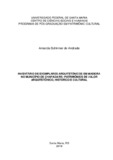| dc.creator | Andrade, Amanda Schirmer de | |
| dc.date.accessioned | 2020-02-27T21:58:32Z | |
| dc.date.available | 2020-02-27T21:58:32Z | |
| dc.date.issued | 2019-11-08 | |
| dc.identifier.uri | http://repositorio.ufsm.br/handle/1/19672 | |
| dc.description.abstract | The present dissertation aimed to analyze wood buildings in the municipality of Chapada / RS, both in architectural and aesthetic aspects, thus being able to compare the thirteen buildings researched in their many characteristics and components, which led to partially understand how people built having possession of this material and popular knowledge. Valuing the assets that still survive in contemporary times, whether material or immaterial, strengthens the relationship between the community and the good. Real estate material assets, today, are the most recognized forms of heritage goods, both for their visibility and their use, as they are part of people's daily lives. In order to catalog the goods, inventory registration forms were used. For the selection of goods, the criterion used was the existence of some architectural singularity, regardless of the area or element that had it. A bibliographical review was carried out about the themes involved (heritage, architecture, immigration, wood and the municipality), field research on buildings, photographic survey, subsequent measurement and redesign of the selected sites for analysis and interpretation between assets. All this so that it was possible to find out how the elements and characteristics were treated by families, without considering the end use of the place. Thus, seeking to deliver the results to the community, an educational brochure was developed to be delivered simultaneously to the photographic exhibition called “Olhares da Arquitetura”, which takes place in an itinerant way, composed of eleven enlarged photos to be inaugurated in Santa Maria, in the Gama d'Eça Educational Museum in 2019, as well as a story published in a local newspaper. | eng |
| dc.language | por | por |
| dc.publisher | Universidade Federal de Santa Maria | por |
| dc.rights | Attribution-NonCommercial-NoDerivatives 4.0 International | * |
| dc.rights.uri | http://creativecommons.org/licenses/by-nc-nd/4.0/ | * |
| dc.subject | Arquitetura | por |
| dc.subject | Patrimônio cultural | por |
| dc.subject | Imigração alemã | por |
| dc.subject | Imigração italiana | por |
| dc.subject | Arquitetura em madeira | por |
| dc.subject | Architecture | eng |
| dc.subject | Cultural patrimony | eng |
| dc.subject | German immigration | eng |
| dc.subject | Italian immigration | eng |
| dc.subject | Wood architecture | eng |
| dc.title | Inventário de exemplares arquitetônicos em madeira no município de Chapada/RS: patrimônios de valor arquitetônico, histórico e cultural | por |
| dc.title.alternative | Inventory of wooden architectural examples in the municipality of Chapada (southern Brazil): architectural, historical and cultural patrimony | eng |
| dc.type | Dissertação | por |
| dc.description.resumo | A presente dissertação teve como objetivo analisar edificações em madeira no município de Chapada/RS, tanto em quesitos arquitetônicos como estéticos, podendo assim comparar as treze edificações pesquisadas em suas tantas características e componentes, o que levou a entender, parcialmente, como as pessoas construíam, tendo posse desse material e do conhecimento popular. Valorizar os patrimônios que ainda sobrevivem na contemporaneidade, sejam de instância material ou imaterial, fortalece a relação entre a comunidade e o bem. Os patrimônios materiais imóveis, hoje, são as formas mais reconhecidas de bens patrimoniais, tanto por sua visibilidade quanto por seu uso, pois integram o cotidiano das pessoas. Para realizar a catalogação dos bens, fez-se uso de fichas cadastrais de inventário. Já para a seleção dos bens, usou-se como critério a existência de alguma singularidade arquitetônica, independentemente da área ou elemento que a tivesse. Realizou-se a revisão bibliográfica acerca das temáticas envolvidas (patrimônio, arquitetura, imigração, madeira e o município), pesquisa de campo sobre as edificações, levantamento fotográfico, posterior medição e redesenho dos locais selecionados para análise e interpretação entre bens. Tudo isso para que fosse possível encontrar a maneira como os elementos e características eram tratados pelas famílias, sem considerar o uso final do local. Assim sendo, buscando entregar para a comunidade os resultados encontrados, foi desenvolvido um panfleto educativo a ser entregue simultaneamente a exposição fotográfica denominada “Olhares da Arquitetura”, que ocorre de maneira itinerante, composta por onze fotos ampliadas que será inaugurada em Santa Maria, no Museu Educativo Gama d’Eça, em 2019, além de uma matéria publicada em um jornal local. | por |
| dc.contributor.advisor1 | Saad, Denise de Souza | |
| dc.contributor.advisor1Lattes | http://lattes.cnpq.br/5104361169659851 | por |
| dc.contributor.referee1 | Lopes, Caryl Eduardo Jovanovich | |
| dc.contributor.referee1Lattes | http://lattes.cnpq.br/0701827238095286 | por |
| dc.contributor.referee2 | Pereira, Clarissa de Oliveira | |
| dc.contributor.referee2Lattes | http://lattes.cnpq.br/1952567883594336 | por |
| dc.creator.Lattes | http://lattes.cnpq.br/8561012695797402 | por |
| dc.publisher.country | Brasil | por |
| dc.publisher.department | História | por |
| dc.publisher.initials | UFSM | por |
| dc.publisher.program | Programa de Pós-Graduação em Patrimônio Cultural | por |
| dc.subject.cnpq | CNPQ::CIENCIAS HUMANAS::HISTORIA | por |
| dc.publisher.unidade | Centro de Ciências Sociais e Humanas | por |



